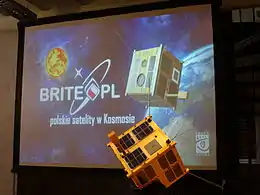BRITE
Bright(-star) Target Explorer or BRITE, also known as Canadian Advanced Nanospace eXperiment 3 (CanX-3) is a constellation of six nanosatellites operated by a consortium of universities from Canada, Austria and Poland.
 A replica of Heweliusz (BRITE-PL) | |
| Country of origin | Canada Austria Poland |
|---|---|
| Applications | Astronomy |
| Specifications | |
| Bus | Generic Nanosatellite Bus |
| Launch mass | 10 kilograms (22 lb) |
| Dimensions | 20 centimetres (7.9 in) cube |
| Regime | Low Earth |
| Dimensions | |
| Production | |
| Status | Operational |
| Built | 6 |
| Launched | 6 |
| Operational | 5 |
| Lost | 1 |
The BRITE satellites were designed by the Institute for Aerospace Studies at the University of Toronto under the Canadian Advanced Nanospace eXperiment Program. The satellites is built around the Generic Nanosatellite Bus, a cube-shaped spacecraft with sides of 20 centimetres (7.9 in) which was first used in current BRITE version for the satellite CanX-3.[1] One satellite is called BRITE-Toronto while the other is called BRITE-Montreal.[2]
BRITE Constellation was included in the #7 entry in the Top Ten Science Stories of 2013, as chosen by Bob McDonald, host of the Canadian Broadcasting Corporation (CBC) radio show Quirks & Quarks, and the main science journalist for CBC radio and television.[3]
Launches
| Satellite name | Launch date | Status | Launch vehicle | Launch site |
|---|---|---|---|---|
| UniBRITE-1 | 2013/02/25 | Operational | PSLV-CA | Satish Dhawan Space Centre First Launch Pad |
| TUGSAT-1 (BRITE-Austria) | 2013/02/25 | Operational | PSLV-CA | Satish Dhawan Space Centre First Launch Pad |
| Lem (BRITE-PL) | 2013/11/21 | Operational | Dnepr | Dombarovsky (air base) Site 13 |
| BRITE-CA 1 (BRITE-Toronto) | 2014/06/19 | Operational | Dnepr | Dombarovsky (air base) Site 13 |
| BRITE-CA 2 (BRITE-Montreal) | 2014/06/19 | Possibly Lost [4][2] | Dnepr | Dombarovsky (air base) Site 13 |
| Heweliusz (BRITE-PL) | 2014/08/19 | Operational[5] | Long March 4B | Taiyuan Satellite Launch Center |
Mission
The satellite is intended for astro-photometry of the brightest stars in single wavelength band. UniBRITE-1, BRITE-Toronto and Heweliusz BRITE-PL photometers are sensitive to the red light, while BRITE-Montreal, Lem BRITE-PL and BRITE-AUSTRIA are sensitive to the blue light.[2]
References
- "BRITE (BRIght-star Target Explorer) Constellation / BRITE Canada". Retrieved November 16, 2016.
- "BRITE-CA 1, 2 (BRITE-Toronto, BRITE-Montreal / CanX 3E, 3F)". Retrieved November 16, 2016.
- "First Polish Scientific Satellite". Retrieved November 16, 2016. First Polish scientific satellite
- "Canadian astronomy satellite lost as another looks for rescue". Retrieved November 16, 2016.
- "Drugi polski satelita naukowy Heweliusz już na orbicie". Retrieved November 16, 2016.